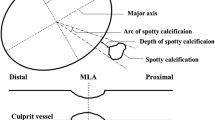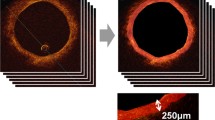Abstract
To investigate the clinical significance of bright spots in coronary plaque detected by optical coherence tomography (OCT) in patients with coronary artery disease. We identified 112 patients [acute coronary syndromes (ACS): n = 50, stable angina pectoris (SAP): n = 62] who underwent OCT imaging of the culprit lesion. A novel OCT algorithm was applied to detect bright spots representing the juxtaposition of a variety of plaque components including macrophages. The density of bright spots within the most superficial 250 μm of the vessel wall was measured at the site of culprit lesion. Bright spot density in the culprit lesion was significantly higher in patients presenting with ACS compared to those presenting with SAP (0.51 ± 0.43 % vs. 0.37 ± 0.26 %, P = 0.04), particularly in the subgroup with ruptured culprit plaque (0.59 ± 0.52 %). Thin-cap fibroatheroma (TCFA) was associated with a trend towards a higher density of bright spots compared to non-TCFA plaques (0.57 ± 0.50 % vs. 0.41 ± 0.31 %, P = 0.08). Similar results were also obtained within 1000 μm depth. Positive linear correlation was demonstrated between bright spot density and hsCRP level (r = 0.45, P = 0.002). Using a novel algorithm, we demonstrated a significantly higher density of bright spots in the culprit lesions of patients presenting with ACS, particularly in case of plaque rupture, compared to those presenting with SAP. The density of bright spots also correlates with inflammatory status. These results suggest that the quantitative assessment of bright spot density may be useful in evaluating plaque vulnerability.





Similar content being viewed by others
References
Jang IK, Tearney GJ, MacNeill B, Takano M, Moselewski F, Iftima N, Shishkov M, Houser S, Aretz HT, Halpern EF, Bouma BE (2005) In vivo characterization of coronary atherosclerotic plaque by use of optical coherence tomography. Circulation 111:1551–1555. doi:10.1161/01.CIR.0000159354.43778.69
Phipps JE, Vela D, Hoyt T, Halaney DL, Mancuso JJ, Buja LM, Asmis R, Milner TE, Feldman MD (2015) Macrophages and intravascular OCT bright spots: a quantitative study. JACC Cardiovasc Imaging 8:63–72. doi:10.1016/j.jcmg.2014.07.027
Yabushita H, Bouma BE, Houser SL, Aretz HT, Jang IK, Schlendorf KH, Kauffman CR, Shishkov M, Kang DH, Halpern EF, Tearney GJ (2002) Characterization of human atherosclerosis by optical coherence tomography. Circulation 106:1640–1645
Tearney GJ, Regar E, Akasaka T, Adriaenssens T, Barlis P, Bezerra HG, Bouma B, Bruining N, Cho JM, Chowdhary S, Costa MA, de Silva R, Dijkstra J, Di Mario C, Dudek D, Falk E, Feldman MD, Fitzgerald P, Garcia-Garcia HM, Gonzalo N, Granada JF, Guagliumi G, Holm NR, Honda Y, Ikeno F, Kawasaki M, Kochman J, Koltowski L, Kubo T, Kume T, Kyono H, Lam CC, Lamouche G, Lee DP, Leon MB, Maehara A, Manfrini O, Mintz GS, Mizuno K, Morel MA, Nadkarni S, Okura H, Otake H, Pietrasik A, Prati F, Raber L, Radu MD, Rieber J, Riga M, Rollins A, Rosenberg M, Sirbu V, Serruys PW, Shimada K, Shinke T, Shite J, Siegel E, Sonoda S, Suter M, Takarada S, Tanaka A, Terashima M, Thim T, Uemura S, Ughi GJ, van Beusekom HM, van der Steen AF, van Es GA, van Soest G, Virmani R, Waxman S, Weissman NJ, Weisz G, International Working Group for Intravascular Optical Coherence T (2012) Consensus standards for acquisition, measurement, and reporting of intravascular optical coherence tomography studies: a report from the International Working Group for Intravascular Optical Coherence Tomography Standardization and Validation. J Am Coll Cardiol 59:1058–1072. doi:10.1016/j.jacc.2011.09.079
Di Vito L, Yoon JH, Kato K, Yonetsu T, Vergallo R, Costa M, Bezerra HG, Arbustini E, Narula J, Crea F, Prati F, Jang IK, Group C (2014) Comprehensive overview of definitions for optical coherence tomography-based plaque and stent analyses. Coron Artery Dis 25:172–185. doi:10.1097/MCA.0000000000000072
Jia H, Abtahian F, Aguirre AD, Lee S, Chia S, Lowe H, Kato K, Yonetsu T, Vergallo R, Hu S, Tian J, Lee H, Park SJ, Jang YS, Raffel OC, Mizuno K, Uemura S, Itoh T, Kakuta T, Choi SY, Dauerman HL, Prasad A, Toma C, McNulty I, Zhang S, Yu B, Fuster V, Narula J, Virmani R, Jang IK (2013) In vivo diagnosis of plaque erosion and calcified nodule in patients with acute coronary syndrome by intravascular optical coherence tomography. J Am Coll Cardiol 62:1748–1758. doi:10.1016/j.jacc.2013.05.071
Johnson TW, Smith D, Strange JW, Bucciarelli-Ducci C, Lowe R, Baumbach A (2012) Spontaneous multivessel coronary intramural hematoma: an insight with OCT. JACC Cardiovasc Imaging 5:1070–1071. doi:10.1016/j.jcmg.2012.03.020
Yonetsu T, Kakuta T, Lee T, Takahashi K, Kawaguchi N, Yamamoto G, Koura K, Hishikari K, Iesaka Y, Fujiwara H, Isobe M (2011) In vivo critical fibrous cap thickness for rupture-prone coronary plaques assessed by optical coherence tomography. Eur Heart J 32:1251–1259. doi:10.1093/eurheartj/ehq518
Tearney GJ, Yabushita H, Houser SL, Aretz HT, Jang IK, Schlendorf KH, Kauffman CR, Shishkov M, Halpern EF, Bouma BE (2003) Quantification of macrophage content in atherosclerotic plaques by optical coherence tomography. Circulation 107:113–119
MacNeill BD, Jang IK, Bouma BE, Iftimia N, Takano M, Yabushita H, Shishkov M, Kauffman CR, Houser SL, Aretz HT, DeJoseph D, Halpern EF, Tearney GJ (2004) Focal and multi-focal plaque macrophage distributions in patients with acute and stable presentations of coronary artery disease. J Am Coll Cardiol 44:972–979. doi:10.1016/j.jacc.2004.05.066
Raffel OC, Tearney GJ, Gauthier DD, Halpern EF, Bouma BE, Jang IK (2007) Relationship between a systemic inflammatory marker, plaque inflammation, and plaque characteristics determined by intravascular optical coherence tomography. Arterioscler Thromb Vasc Biol 27:1820–1827. doi:10.1161/ATVBAHA.107.145987
Virmani R, Burke AP, Farb A, Kolodgie FD (2006) Pathology of the vulnerable plaque. J Am Coll Cardiol 47:C13–C18. doi:10.1016/j.jacc.2005.10.065
Virmani R, Kolodgie FD, Burke AP, Farb A, Schwartz SM (2000) Lessons from sudden coronary death: a comprehensive morphological classification scheme for atherosclerotic lesions. Arterioscler Thromb Vasc Biol 20:1262–1275
Pedrigi RM, de Silva R, Bovens SM, Mehta V, Petretto E, Krams R (2014) Thin-cap fibroatheroma rupture is associated with a fine interplay of shear and wall stress. Arterioscler Thromb Vasc Biol. doi:10.1161/ATVBAHA.114.303426
Libby P, Geng YJ, Aikawa M, Schoenbeck U, Mach F, Clinton SK, Sukhova GK, Lee RT (1996) Macrophages and atherosclerotic plaque stability. Curr Opin Lipidol 7:330–335
Moreno PR, Falk E, Palacios IF, Newell JB, Fuster V, Fallon JT (1994) Macrophage infiltration in acute coronary syndromes. Implications for plaque rupture. Circulation 90:775–778
van der Wal AC, Becker AE, van der Loos CM, Das PK (1994) Site of intimal rupture or erosion of thrombosed coronary atherosclerotic plaques is characterized by an inflammatory process irrespective of the dominant plaque morphology. Circulation 89:36–44
Galis ZS, Sukhova GK, Kranzhofer R, Clark S, Libby P (1995) Macrophage foam cells from experimental atheroma constitutively produce matrix-degrading proteinases. Proc Natl Acad Sci USA 92:402–406
Shah PK, Falk E, Badimon JJ, Fernandez-Ortiz A, Mailhac A, Villareal-Levy G, Fallon JT, Regnstrom J, Fuster V (1995) Human monocyte-derived macrophages induce collagen breakdown in fibrous caps of atherosclerotic plaques. Potential role of matrix-degrading metalloproteinases and implications for plaque rupture. Circulation 92:1565–1569
Vengrenyuk Y, Carlier S, Xanthos S, Cardoso L, Ganatos P, Virmani R, Einav S, Gilchrist L, Weinbaum S (2006) A hypothesis for vulnerable plaque rupture due to stress-induced debonding around cellular microcalcifications in thin fibrous caps. Proc Natl Acad Sci USA 103:14678–14683. doi:10.1073/pnas.0606310103
Mizukoshi M, Kubo T, Takarada S, Kitabata H, Ino Y, Tanimoto T, Komukai K, Tanaka A, Imanishi T, Akasaka T (2013) Coronary superficial and spotty calcium deposits in culprit coronary lesions of acute coronary syndrome as determined by optical coherence tomography. Am J Cardiol 112:34–40. doi:10.1016/j.amjcard.2013.02.048
Nakamura S, Inami S, Murai K, Takano M, Takano H, Asai K, Yasutake M, Shimizu W, Mizuno K (2014) Relationship between cholesterol crystals and culprit lesion characteristics in patients with stable coronary artery disease: an optical coherence tomography study. Clin Res Cardiol. doi:10.1007/s00392-014-0748-5
Grebe A, Latz E (2013) Cholesterol crystals and inflammation. Curr Rheumatol Rep 15:313. doi:10.1007/s11926-012-0313-z
Tian J, Ren X, Vergallo R, Xing L, Yu H, Jia H, Soeda T, McNulty I, Hu S, Lee H, Yu B, Jang IK (2014) Distinct morphological features of ruptured culprit plaque for acute coronary events compared to those with silent rupture and thin-cap fibroatheroma: a combined optical coherence tomography and intravascular ultrasound study. J Am Coll Cardiol 63:2209–2216. doi:10.1016/j.jacc.2014.01.061
Libby P, Ridker PM, Maseri A (2002) Inflammation and atherosclerosis. Circulation 105:1135–1143
Avanzas P, Arroyo-Espliguero R, Cosin-Sales J, Aldama G, Pizzi C, Quiles J, Kaski JC (2004) Markers of inflammation and multiple complex stenoses (pancoronary plaque vulnerability) in patients with non-ST segment elevation acute coronary syndromes. Heart 90:847–852. doi:10.1136/hrt.2003.015826
Li JJ, Jiang H, Huang CX, Fang CH, Tang QZ, Xia H, Liu J, Li GS (2002) Elevated level of plasma C-reactive protein in patients with unstable angina: its relations with coronary stenosis and lipid profile. Angiology 53:265–272
Acknowledgments
The authors thank all the investigators, all supporting staff, and all the institutions of MGH OCT Registry for their contributions. The authors also thank Austin McElroy for his contribution to the development of the bright spot algorithm.
Source of funding
This study is supported by St. Jude Medical, Medtronic Corporation, Boston Scientific Corporation, Mr. and Mrs. Michael Park and Dr John Nam, Clayton Foundation in Houston, Texas, Veterans Administration Merit Grant I01 BX000397, and American Heart Association Grant 13POST17080074.
Author information
Authors and Affiliations
Corresponding author
Ethics declarations
Conflict of interest
None.
Electronic supplementary material
Below is the link to the electronic supplementary material.
Table 1
Bright spot density within 250 μm according to the baseline characteristics (DOC 35 kb)
Table 2
Bright spot density within 1000 μm according to the baseline characteristics (DOC 35 kb)
Fig. 1
Comparison of bright spot density within 1000 μm according to the plaque characteristics (TIFF 248 kb)
Fig. 2
Correlation between bright spot density within 1000 μm and inflammatory marker and OCT findings (TIFF 195 kb)
Rights and permissions
About this article
Cite this article
Minami, Y., Phipps, J.E., Hoyt, T. et al. Clinical utility of quantitative bright spots analysis in patients with acute coronary syndrome: an optical coherence tomography study. Int J Cardiovasc Imaging 31, 1479–1487 (2015). https://doi.org/10.1007/s10554-015-0714-y
Received:
Accepted:
Published:
Issue Date:
DOI: https://doi.org/10.1007/s10554-015-0714-y




